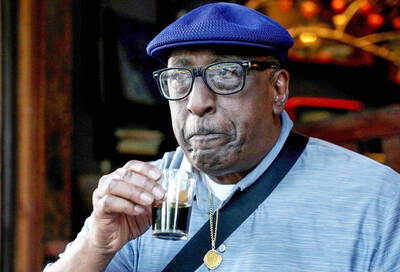U-Theatre (優劇場) founder and director Liu Ruo-yu (劉若瑀) and drumming director Huang Chih-chun (黃誌群) succeeded in bringing the magic of their beloved Laoquanshan (老泉山) home inside in the National Theater on Saturday night.
The Mountain Dawn was simply beautiful — deceptively so. Each element alone was spare and stark: the music, the Gurjieff movements (sacred dancing), the staging, the lighting, the costumes. But mixed gently together, layer upon layer, the result was a quietly satisfying evening.
The six chapters in the show explored a day in the life of the mountain, beginning with a vibrant burst of drumming that heralded a new day. All those drums inside a confined space can get very loud, and at one point you had to feel pity for the di flautist, standing on a riser behind the drummers, but he battled on, his flute soaring above the drums.
Costume designer Tim Yip (葉錦添) gave the troupe a three-piece unisex costume that consisted of close-fitting sleeveless tops, a voluminous skirt that combined wide-legged trousers with front and back panels tied at the waist and a long, open-front robe. The meters of material in the skirts provided floating layers and quiet rustles for the dance segments.
Yip’s muted palette — the lightest and palest of blues and greens — served to complement stage and lighting designer Lin Keh-hua’s (林克華) work, which blazed with rich colors: strong mauves, deep teals, blues, greens and a beautiful pinky-orange that exactly captured the hue of so many sunsets seen in Taipei. The staging was minimal — a raised platform along the back of the stage, a large rock outcropping on the backdrop — so the lighting set the stage for each segment.
While the drumming is what U-Theatre is famous for, the group has increasingly incorporated sacred dancing into its practice over the past 10 years, culminating in the 2006 production River Journey. The precision of the ritual gestures and their quietness was once again used to great effect in the bamboo and night mist segments.
But it was Huang’s sunset solo that stole the show. He slowly started turning, right arm outstretched from the shoulder, hand holding a stick, the first small circle gradually widening until he was traversing the stage. At the apex of each spin, his arm would come down to strike the drum he held under his left arm. He spun and spun and spun and then just stopped. The amazing thing wasn’t just that he hit his mark, it was that he stood stock-still; you could barely see his breathing. And then he walked offstage.
I have only one complaint about The Mountain Dawn: it ended. U-Theatre left the audience wanting more; there was none of the usual edging toward the exits when the company turned to face the audience and took their first bow. People stayed in their seats, clapping hard through five curtain calls, and they would have called the troupe back to the stage again if the theater lights had not come up.
The U-Theatre troupe has a day off today before heading off to Israel for a three-city tour, its second to that country. The company will be back to perform The Mountain Dawn on April 10 and April 11 in Kaohsiung City and then takes a month-long break for a group retreat before performing in Taichung City on May 15 and May 16.

On April 26, The Lancet published a letter from two doctors at Taichung-based China Medical University Hospital (CMUH) warning that “Taiwan’s Health Care System is on the Brink of Collapse.” The authors said that “Years of policy inaction and mismanagement of resources have led to the National Health Insurance system operating under unsustainable conditions.” The pushback was immediate. Errors in the paper were quickly identified and publicized, to discredit the authors (the hospital apologized). CNA reported that CMUH said the letter described Taiwan in 2021 as having 62 nurses per 10,000 people, when the correct number was 78 nurses per 10,000

As we live longer, our risk of cognitive impairment is increasing. How can we delay the onset of symptoms? Do we have to give up every indulgence or can small changes make a difference? We asked neurologists for tips on how to keep our brains healthy for life. TAKE CARE OF YOUR HEALTH “All of the sensible things that apply to bodily health apply to brain health,” says Suzanne O’Sullivan, a consultant in neurology at the National Hospital for Neurology and Neurosurgery in London, and the author of The Age of Diagnosis. “When you’re 20, you can get away with absolute

May 5 to May 11 What started out as friction between Taiwanese students at Taichung First High School and a Japanese head cook escalated dramatically over the first two weeks of May 1927. It began on April 30 when the cook’s wife knew that lotus starch used in that night’s dinner had rat feces in it, but failed to inform staff until the meal was already prepared. The students believed that her silence was intentional, and filed a complaint. The school’s Japanese administrators sided with the cook’s family, dismissing the students as troublemakers and clamping down on their freedoms — with

As Donald Trump’s executive order in March led to the shuttering of Voice of America (VOA) — the global broadcaster whose roots date back to the fight against Nazi propaganda — he quickly attracted support from figures not used to aligning themselves with any US administration. Trump had ordered the US Agency for Global Media, the federal agency that funds VOA and other groups promoting independent journalism overseas, to be “eliminated to the maximum extent consistent with applicable law.” The decision suddenly halted programming in 49 languages to more than 425 million people. In Moscow, Margarita Simonyan, the hardline editor-in-chief of the